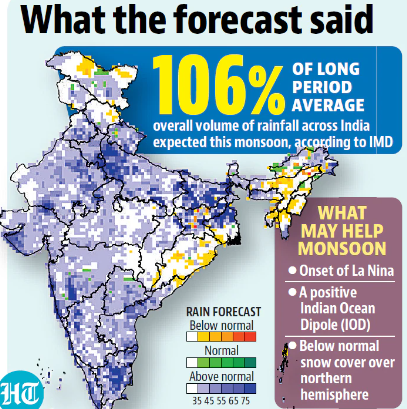India to get ‘above normal’ rain this monsoon season, IMD forecasts (GS Paper 3, Environment & Ecology)

Why in news?
- India is likely to receive above normal rainfall during the upcoming June-September southwest monsoon season, the India Meteorological Department (IMD) predicted in its first long-range seasonal forecast issued on April 15, 2024.
- This is the first time, after a gap of eight years, that the IMD has forecast “above normal” rains in the country. This above normal seasonal rainfall was “very likely” over most parts of the country, the IMD said, except in some areas over northwest, east and northeast India, where below normal rainfall was “very likely”.
- If distributed fairly across the country, the forecast should be a cause of cheer, especially for agriculture and a time when 35.7 percent area in the country was under ‘abnormal’ to ‘exceptional’ degrees of drought, with different parts facing water shortages.
Expected Seasonal Rainfall
- Quantitatively, the seasonal rainfall over the country as a whole is likely to be 106 per cent of Long Period Average (LPA).
- The IMD categorises the seasonal rainfall as above-normal when it ranges between 105-110 per cent of the LPA.
- The LPA for the period between June and September is 87 centimetres (870 mm) and is calculated as the average rainfall between 1971-2020. By this calculation, it means that there would be 92.2 cm of rainfall across India.
The forecast is based on four main factors:
- Retreat of El Nino.
- Favourable La Nina conditions.
- Positive Indian Ocean Dipole (IOD).
- Reduced snow cover in Northern Hemisphere.
El Nino & La Nina
- El Nino conditions, currently prevailing over the equatorial Pacific region and generally responsible for warmer temperatures in many places around the world including in India, were likely to weaken to neutral El Nino Southern Oscillation (ENSO) conditions during early part of the monsoon season.
- The warming phase of ENSO cycle is known as El Nino and its cooling phase as La Nina. It is characterised by the unusual cooling of the central and east-central equatorial Pacific Ocean.
- “La Nina conditions are likely to develop during second half of monsoon season.
- At present, neutral IOD conditions are prevailing over the Indian Ocean and the latest climate model forecasts indicate that the positive IOD conditions are likely to develop during the later part of the southwest monsoon season,” the IMD said.
Forecast in various Areas
- IMD also pointed out that winter and spring snow cover extent over the Northern Hemisphere as well as Eurasia has a generally inverse relationship with the subsequent Indian summer monsoon rainfall.
- The Northern Hemisphere snow cover areas during January to March 2024 were observed to be below normal.
- The forecast shows that most of India will receive above normal rainfall, except for parts in Ladakh, Himachal Pradesh, Assam, Tripura, Mizoram, Manipur, West Bengal, and Odisha, which were likely to receive below normal rains (see map below).
- The last time India’s official weather forecaster issued an “above normal” rainfall prediction was in 2016, which came after two consecutive drought years.
Impact on Indian Economy
- India receives 70-90 per cent of its annual rainfall in the four months of June-September.
- A normal and well-distributed monsoon is crucial for the 61 per cent of Indian farmers, who are dependent on rains for practising agriculture.
- The monsoon has a direct impact on India’s economy. Uniform distribution leads to a successful monsoon season, which boosts farm production and incomes of both farmers and labourers.
- This has an impact on rural household incomes, which then stimulates demand for goods and services, especially rural demand.
Way Forward
- The onset of the monsoon over mainland India happens on June 1.
- IMD issues the operational long-range forecast for the southwest monsoon in two stages. The first stage forecast is issued in April and the second stage updated forecast is issued by the end of May.
- The monsoon forecast comes days after the IMD had predicted intense heatwwave conditions in the summer season of April-May-June.


